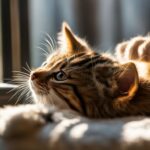Have you ever wondered why your cat has suddenly taken a liking to licking your hair? This seemingly peculiar behavior can leave cat owners perplexed. But fear not, for I am here to shed some light on this furry mystery.
Cats have a natural instinct for grooming, and they extend this behavior not only to themselves but also to their favorite humans. So, when your cat licks your hair, it’s actually a sign of affection and a way for them to strengthen the bond between the two of you.
When cats groom each other, it’s a way for them to enhance social bonds and exchange scents. By licking your hair, your cat is essentially marking you as a part of their social group and sharing their scent with you. It’s their way of saying, “You belong with me.”
Now, you may be wondering about the rough texture of your cat’s tongue. Well, a cat’s tongue is covered in tiny backward-facing barbs called papillae, which are made of keratin. These barbs serve multiple purposes, including efficient grooming and spreading saliva onto the hair coat, cleansing the skin, and controlling the cat’s temperature.
It’s important to note that in most cases, allowing your cat to lick your hair is harmless, as long as they don’t swallow it. Swallowing hair can lead to the formation of hairballs, which can be problematic for your cat’s digestive system. So, it’s essential to keep an eye on their grooming habits.
Key Takeaways:
- Cats lick human hair as a sign of affection and to strengthen the bond between them and their favorite humans.
- Grooming behavior is a way for cats to enhance social bonds and exchange scents.
- A cat’s rough tongue is equipped with barbs that help remove loose hairs and cleanse the skin.
- Allowing your cat to lick your hair is generally harmless, but be cautious of hairball formation.
- Monitoring your cat’s grooming habits is important to ensure their well-being.
The Terrific Tongues of Cats
Cats have truly fascinating tongues. Have you ever wondered why a cat’s tongue feels so rough? It’s because their tongues are covered in hundreds of small backward-facing barbs called papillae. Made of keratin, these papillae serve multiple functions in a cat’s daily grooming routine.
The rough texture of a cat’s tongue helps them remove loose hairs, dirt, stale oil, and parasites from their fur. As they groom themselves, these barbs catch and pull out any debris, leaving their coat clean and free of unwanted hitchhikers. Additionally, the shape of the papillae allows cats to absorb saliva and distribute it onto their fur, which cleanses their skin and helps regulate their body temperature.
If you take a closer look at your cat’s tongue, you’ll notice that the papillae are precisely designed to serve these grooming purposes. The barbs on a cat’s tongue are angled backward like little hooks, making them highly effective at catching and removing anything that shouldn’t be in their fur. It’s truly a remarkable adaptation that showcases the natural efficiency of feline grooming.
The Terrific Tongues of Cats
| Papillae | Functions |
|---|---|
| Rough Texture | Aids in removing loose hairs, dirt, oil, and parasites |
| Backward-Facing Barbs | Allows for effective catching and pulling out debris |
| Saliva Absorption | Helps in distributing saliva to cleanse the skin and regulate body temperature |
The unique structure of a cat’s tongue is not only a testament to their grooming abilities but also plays a vital role in their overall well-being. So, the next time you feel the rough texture of your cat’s tongue as they groom themselves or give you affectionate licks, you can marvel at the fantastic design that nature has bestowed upon our feline friends.
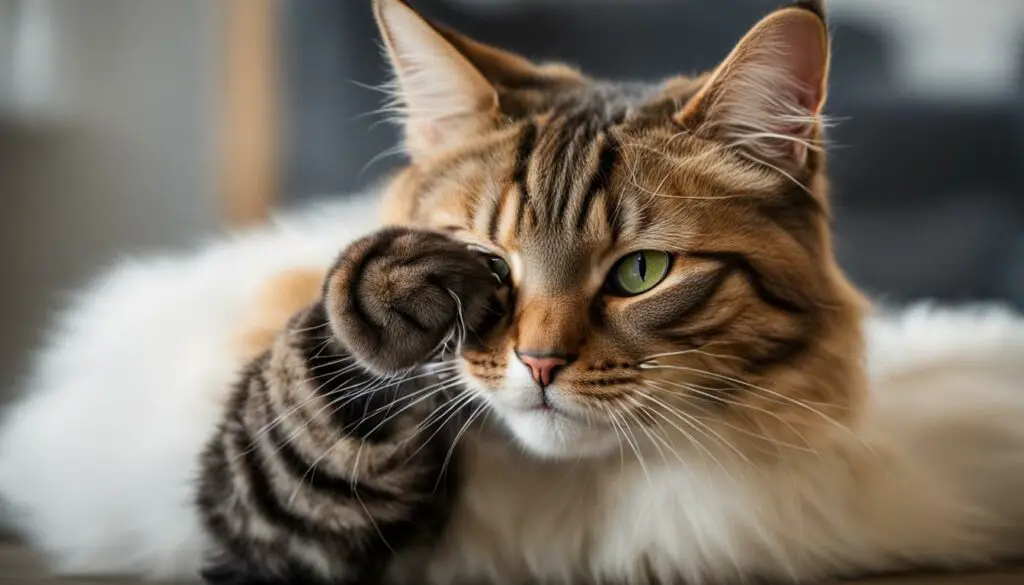
Normal Cat Grooming Behavior
Cats are natural groomers, and grooming is an essential part of their daily routine. They engage in two types of grooming: self-grooming and social grooming. Self-grooming is when a cat cleans itself by licking its fur, while social grooming involves cats grooming each other to strengthen bonds within their social group.
Self-grooming is a fundamental behavior that cats learn from their mothers when they are kittens. It helps them keep their fur clean and free from dirt, parasites, and excess oils. Cats have specialized grooming tools—their tongues—that are covered in small, backward-facing barbs called papillae. These papillae act as mini combs, helping to remove any loose hairs or debris from their fur.
Social grooming, also known as allogrooming, is a bonding ritual among cats. It helps them exchange scents and reinforce social relationships. During social grooming sessions, cats groom each other’s heads, necks, and other hard-to-reach areas. It’s a way for cats to show affection, establish trust, and communicate through grooming rituals and body language.
By engaging in both self-grooming and social grooming, cats maintain their hygiene, form social bonds, and communicate with others in their social group. This grooming behavior is a natural instinct that is ingrained in their behavior and plays a vital role in their overall well-being.
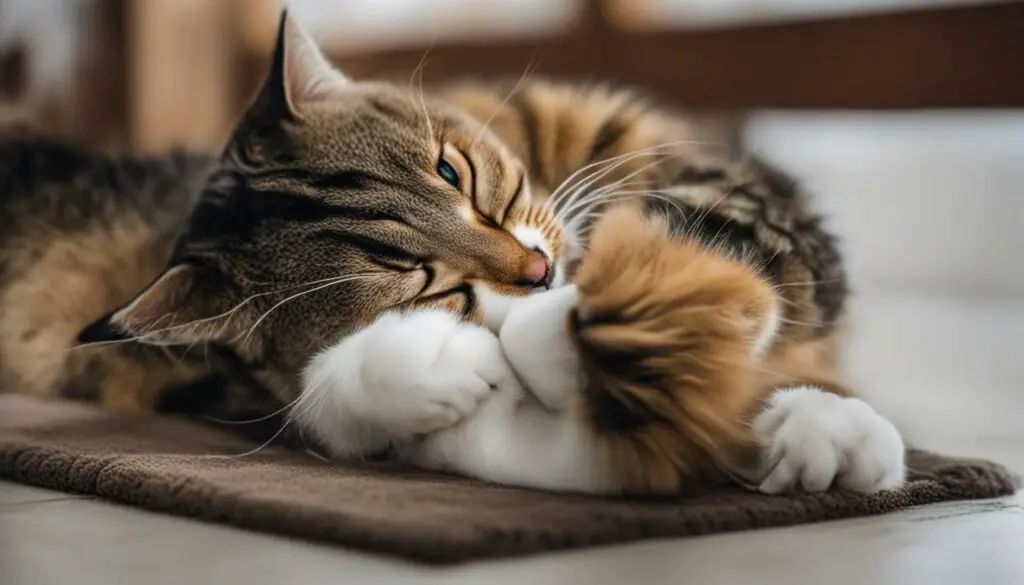
| Grooming Behavior | Description |
|---|---|
| Self-grooming | Cats clean themselves by licking their fur, using their tongues’ backward-facing barbs to remove loose hairs, dirt, and parasites. |
| Social grooming | Cats groom each other to strengthen social bonds, exchange scents, and communicate through grooming rituals and body language. |
“Grooming is an important part of a cat’s life. It helps them maintain their cleanliness, keep their fur healthy, and strengthen relationships within their social group.” – Dr. Emily Johnson, Veterinarian
Grooming is not only a physical act but also a way for cats to express their affection and belongingness. The bond that is formed through grooming fosters a sense of security and promotes a harmonious coexistence within a social group. As cat owners, it’s important to appreciate and support their natural grooming behaviors to ensure their overall happiness and well-being.
Why Do Cats Groom Each Other?
When it comes to cats grooming each other, there are several reasons behind this behavior. One of the main reasons is to strengthen social bonds. Allogrooming, or social grooming, allows cats to communicate and reinforce their relationships with other cats. By grooming each other, they can exchange scents and identify members of their social group, promoting a sense of belonging and security.
Scent marking is another significant aspect of cats grooming each other. When cats groom each other, they spread their scent onto the other cat’s fur, marking them as part of their territory and indicating a friendly association. This scent exchange is crucial for cats in establishing their social hierarchy and maintaining harmony within their group.
In addition to social bonding and scent marking, grooming each other can also be a display of dominance. Higher-ranking cats often groom lower-ranking cats as a way to assert their dominance and maintain control over their territory. It serves as a non-aggressive way for cats to establish their rank and avoid conflicts.
Table: Reasons for Cats Grooming Each Other
| Reasons | Description |
|---|---|
| Strengthening Social Bonds | Grooming each other helps cats communicate and reinforce their relationships with other cats. |
| Scent Marking | Cats spread their scent onto each other’s fur, marking them as part of their territory and indicating a friendly association. |
| Display of Dominance | Higher-ranking cats groom lower-ranking cats to assert their dominance and maintain control over their territory. |
Understanding why cats groom each other can provide insight into their social dynamics and behaviors. It is a natural and instinctive behavior that serves multiple purposes, including promoting social bonds, maintaining territorial boundaries, and establishing dominance within a group. Cats have a complex and fascinating way of communicating and connecting with each other, and grooming is an essential part of their social interactions.
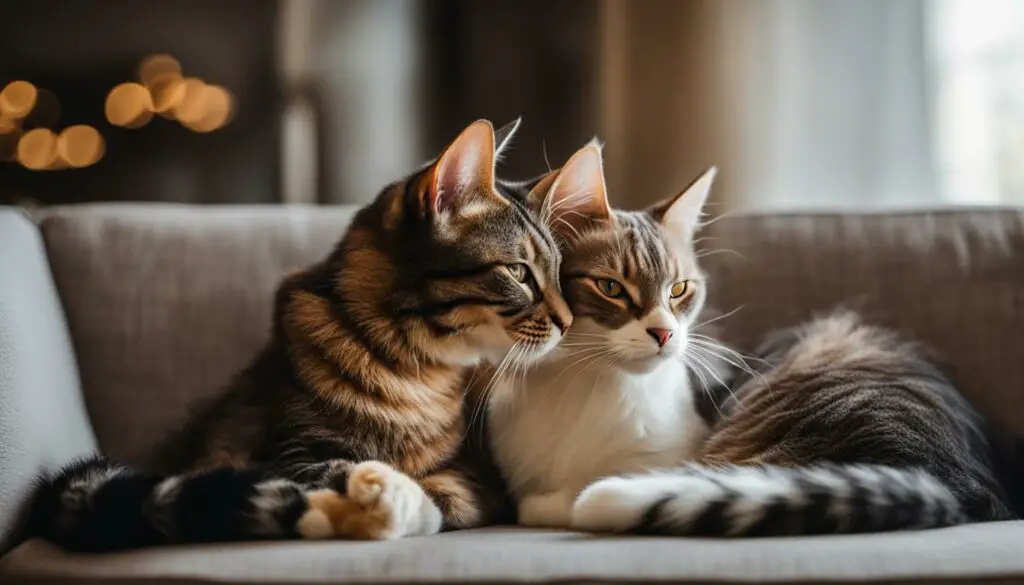
So Why Does My Cat Lick My Hair?
When your cat licks your hair, it is a sign of affection and an attempt to reinforce the bond between you. Cats groom the heads and necks of their preferred associates, and by licking your hair, they are sharing their scent with you. It may also be a way for your cat to seek attention and enjoy the physical interaction that comes with hair-licking.
| Reasons why cats lick human hair: | Explanation |
|---|---|
| Affection | Cats show their love and affection through grooming behaviors, and licking your hair is one way they express their fondness for you. |
| Scent sharing | Cats have scent glands in their mouths, and when they lick your hair, they are depositing their scent on you, marking you as a part of their social group. |
| Attention-seeking | By licking your hair, cats can grab your attention and engage in a playful interaction with you. |
| Grooming behavior | When cats groom, it stimulates the release of endorphins, which can provide them with a sense of relaxation and pleasure. Licking your hair may simply be a behavior that brings comfort to your cat. |
It’s important to note that while cat hair-licking is generally harmless, there are some factors to consider. If your cat starts swallowing the hair, it can lead to the formation of hairballs, which may require medical intervention. Additionally, ensure that the hair products you use are safe for cats as they could accidentally ingest them during grooming sessions. Pay attention to your cat’s grooming behavior and consult a veterinarian if you have any concerns.
Remember, bonding with your cat is a special part of the human-feline relationship, and allowing them to lick your hair can be a way to strengthen that bond. Just be mindful of their health and well-being as you enjoy this unique display of affection.
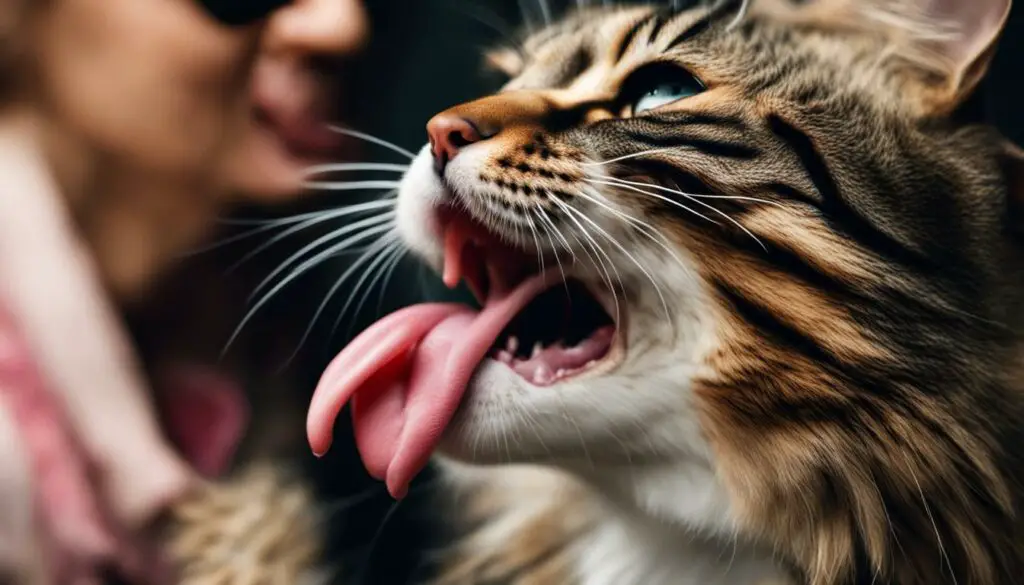
Is Cat Hair Licking Harmful?
While it is generally harmless for cats to lick human hair, there are some health concerns to be aware of. One potential issue is when cats swallow hair during the grooming process. This can lead to the formation of hairballs, which may cause intestinal blockages and may require surgery to remove. It’s important to monitor your cat’s grooming behavior and make sure they are not excessively ingesting hair.
Another consideration is the use of hair and skin products that you may be using. Some products contain ingredients that can be toxic to cats if they come into contact with them or lick them off your hair. It’s essential to check the ingredients of your hair products and ensure they are safe for your feline friend.
If your cat is excessively grooming and eating hair, it may be a sign of pica, a condition where cats ingest non-food items. It is important to consult with a veterinarian to rule out any underlying medical issues and discuss appropriate management strategies.
Table: Potential Health Concerns Related to Cat Hair Licking
| Health Concern | Description |
|---|---|
| Hairballs | Swallowing hair can lead to the formation of hairballs, which may cause intestinal blockages and require surgery. |
| Toxic Products | Certain hair and skin products may contain ingredients that are toxic to cats if ingested or absorbed through their skin. |
| Pica | Excessive grooming and ingestion of hair may be a sign of pica, a condition where cats eat non-food items. Medical evaluation and management may be necessary. |
It’s important to be mindful of these potential health concerns and take appropriate measures to ensure your cat’s well-being. Regular veterinary check-ups can help identify any issues early on and provide guidance on maintaining a healthy grooming routine for your feline friend.
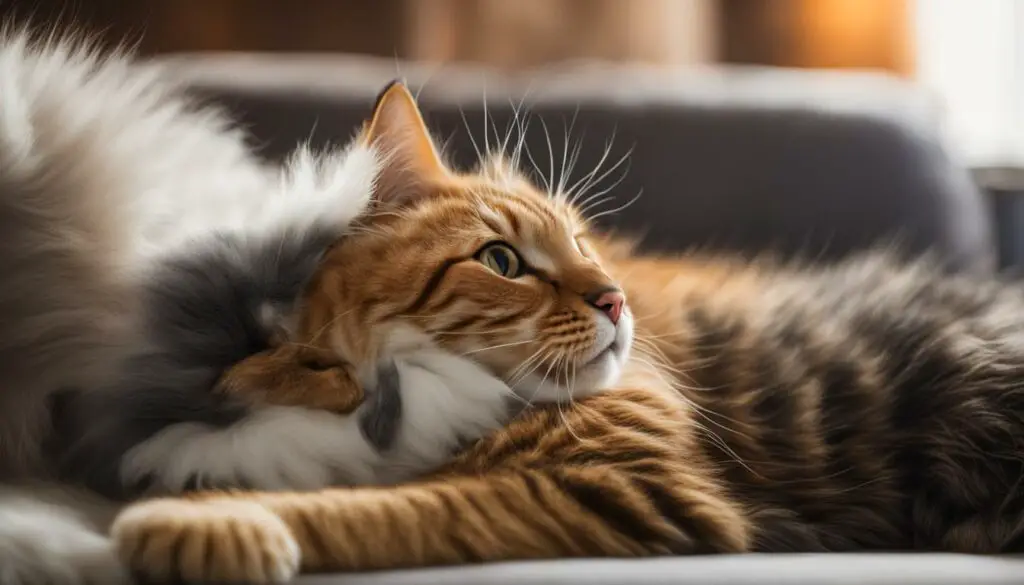
How to Discourage Hair Licking
If you want to discourage your cat from licking your hair, there are several strategies you can try:
1. Change Hair Products
Consider switching to hair products with scents that cats don’t like, such as citrus. Cats have strong olfactory senses, and certain fragrances may deter them from licking your hair.
2. Provide Distractions
Offer your cat alternative activities and toys to redirect their attention away from hair-licking. Interactive toys, puzzle feeders, and scratching posts can engage your cat and provide them with mental and physical stimulation.
3. Avoid Reinforcing the Behavior
Be cautious not to unintentionally reinforce the hair-licking behavior. Avoid giving treats or providing extra attention when your cat licks your hair. Instead, redirect their focus to more appropriate behaviors and reward them for engaging in those activities.
4. Enrichment and Environmental Changes
Ensure your cat’s environment is enriched with plenty of vertical spaces, hiding spots, and interactive play areas. This can help alleviate boredom and reduce the likelihood of excessive grooming. Additionally, provide plants or cat grass for your cat to chew on, as it can help satisfy their oral needs.
By implementing these strategies, you can discourage your cat from licking your hair and redirect their behavior to more appropriate outlets.
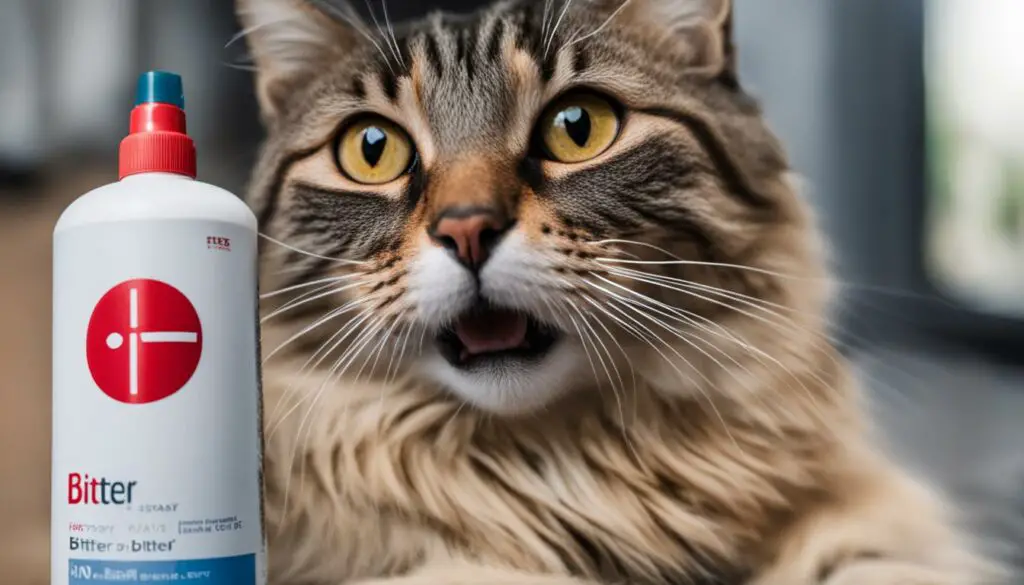
| Methods to Discourage Hair Licking | Effectiveness |
|---|---|
| Changing hair products | Varies depending on individual cat preferences |
| Providing distractions and toys | Can be effective in redirecting attention |
| Avoiding reinforcement | Important to prevent rewarding undesired behavior |
| Enrichment and environmental changes | Can help satisfy cat’s physical and mental needs |
Remember, it’s important to be patient and consistent when discouraging hair licking. Every cat is unique, and it may take some time to find the most effective approach for your furry friend.
Cat Licking as a Sign of Stress
Cats are known for their grooming behaviors, and while licking themselves and others is generally considered normal, excessive grooming can be a sign of stress or anxiety in cats. Just like humans, cats can experience stress, and it can manifest in various ways, including compulsive grooming.
Stress-related grooming may occur due to changes in the cat’s environment, such as moving to a new home, the introduction of a new pet, or a disruption in their routine. Cats may also groom excessively in response to underlying medical conditions or emotional distress.
If your cat is exhibiting signs of stress-related grooming, such as hair loss, skin lesions, or persistent licking in specific areas, it’s essential to address the underlying cause. Consulting with a veterinarian is the first step in determining if there are any medical issues contributing to the behavior. The veterinarian may recommend medication or other treatments to help manage the cat’s stress and reduce the compulsive grooming behavior.
In addition to medical interventions, behavior therapy can also be beneficial in helping cats cope with stress. Behavior modification techniques, such as providing a calm and enriched environment, establishing a consistent routine, and offering interactive toys and playtime, can help redirect the cat’s energy and reduce anxiety.
| Signs of Stress-Related Grooming | Causes | Treatment Options |
|---|---|---|
| Excessive grooming | Environmental changes | Consultation with a veterinarian |
| Hair loss | Underlying medical conditions | Medication |
| Skin lesions | Emotional distress | Behavior therapy |
It’s important to remember that each cat is unique, and the underlying cause of their stress-related grooming may vary. Patience and a compassionate approach are crucial in helping your cat overcome their stress and reducing their compulsive grooming behavior.
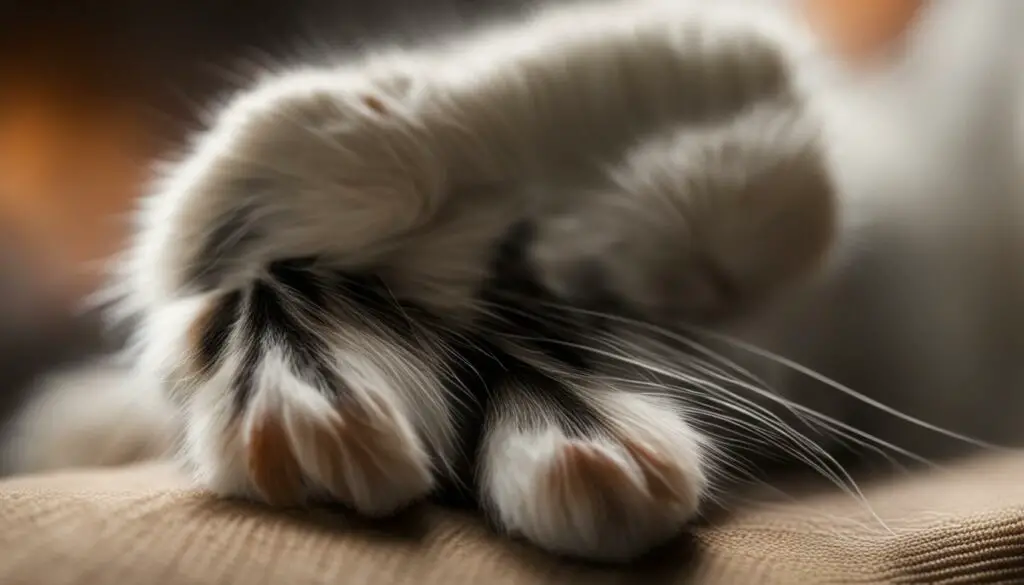
Quote
“A cat’s excessive grooming can be a cry for help. By addressing their stress and providing appropriate treatment, we can help them lead happier and healthier lives.” – Dr. Sarah Thompson, DVM
The Science Behind Cat Licking

Cats’ grooming behaviors, including licking, are rooted in their biology and instincts. One of the fascinating aspects of cat licking is the unique structure of their tongues. A cat’s tongue is covered with tiny, backward-facing barbs called papillae, which give it a rough and textured feel. These barbs serve several functions, including efficient grooming and scent marking.
The barbed texture of a cat’s tongue allows them to remove loose fur, dirt, and parasites from their own bodies during self-grooming. This aids in maintaining a clean and healthy coat. Additionally, when cats groom themselves or other cats, the papillae help distribute saliva onto the fur, which acts as a natural conditioner and cleanser.
Moreover, cat licking not only helps with grooming but also serves as a means of scent marking. By licking their own fur or that of their feline companions, cats deposit their unique scent onto the fur. This behavior is a way for cats to communicate with other animals and mark their territories. The scent left behind acts as a familiar and comforting signal, promoting relaxation and a sense of comfort.
Cats Grooming Humans: Signs of Affection
When cats groom humans, it is a heartwarming sign of affection and bonding. It signifies a level of trust and allows cats to engage in intimate behaviors with their favorite humans. Grooming can be accompanied by other affectionate behaviors like headbutting, kneading, and purring. Cats may also groom their humans as a way to invite play and interaction.
Grooming sessions with your cat can be a special time for both of you to bond. It is a moment of shared intimacy where your cat shows their love and appreciation for you. The gentle strokes of their tongue on your hair or skin can create a sense of comfort and relaxation for both you and your feline companion.
“Cats groom their humans as a way to express their affection and strengthen the bond between them.”
Through grooming, cats also communicate their social status and establish a hierarchy within their social group. By grooming you, your cat is essentially marking you with their scent, showing other cats that you are an important and valued member of their social circle. It’s their way of saying, “You belong with me.”
Table: Affectionate Behaviors Displayed by Cats During Grooming
| Affectionate Behavior | Description |
|---|---|
| Headbutting | Cats gently bump their heads against you to show love and mark you with their scent. |
| Kneading | Cats knead their paws on your lap or against your body as a sign of contentment and trust. |
| Purring | Cats purr to express happiness and relaxation, signaling that they feel safe and comfortable in your presence. |
Next time your cat decides to groom you, cherish this affectionate gesture and reciprocate their love and attention. Engage in playfulness, give them gentle strokes, and create a joyful atmosphere that deepens the bond between you and your furry companion.
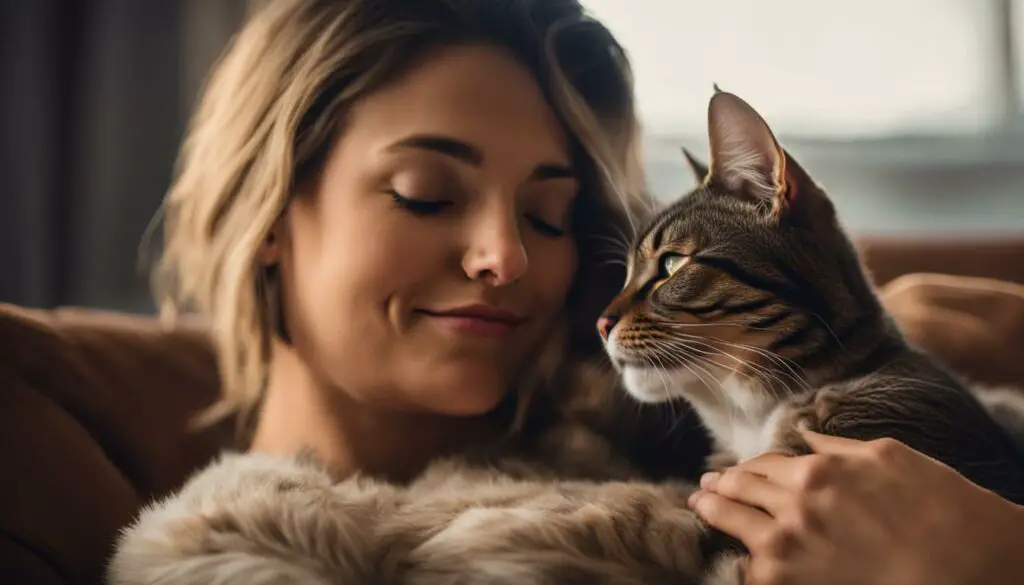
Understanding Abnormal Grooming Behaviors
Compulsive grooming, excessive hair loss, and skin lesions can be concerning signs of abnormal grooming behaviors in cats. These behaviors may indicate underlying medical causes that require attention and treatment. Some of the common medical causes associated with these abnormal grooming behaviors include:
- Allergies: Cats can develop allergies to certain foods, environmental factors, or substances they come into contact with, leading to excessive grooming and skin irritation.
- Parasites: Infestations of fleas, mites, or ticks can cause intense itching and discomfort, prompting cats to excessively groom and scratch themselves.
- Pain: Cats experiencing pain or discomfort, such as from arthritis or injuries, may engage in excessive grooming as a way to alleviate their discomfort.
- Skin diseases: Certain skin conditions, like dermatitis or fungal infections, can trigger itching and irritation, leading to excessive grooming.
- Other health conditions: Underlying health issues, such as hormonal imbalances or autoimmune disorders, can manifest in abnormal grooming behaviors.
If you observe your cat engaging in compulsive grooming, excessive hair loss, or the development of skin lesions, it is crucial to consult with a veterinarian. A thorough examination and appropriate diagnostic tests can help identify the underlying medical causes and guide the treatment plan. Early detection and intervention are key to ensuring the well-being and comfort of your feline companion.
Table:
Common Medical Causes of Abnormal Grooming Behaviors
| Cause | Description |
|---|---|
| Allergies | Reacting to certain foods, environmental factors, or substances |
| Parasites | Fleas, mites, or ticks infestation causing intense itching |
| Pain | Discomfort from arthritis, injuries, or other sources |
| Skin diseases | Dermatitis, fungal infections, or other conditions affecting the skin |
| Other health conditions | Hormonal imbalances, autoimmune disorders, or other underlying issues |
“Compulsive grooming, excessive hair loss, and skin lesions can be indicative of various medical causes in cats. Seeking veterinary care and diagnosis is crucial for proper treatment and management.”
It is important to remember that while medical causes are common, there can also be behavioral factors contributing to abnormal grooming behaviors. Cats may groom excessively in response to stress, anxiety, or boredom. Determining the underlying cause through a thorough veterinary evaluation can help differentiate between medical and behavioral causes and guide the appropriate course of action.
When Excessive Grooming Requires Intervention
Excessive grooming in cats can sometimes indicate underlying issues that require intervention. If your cat is engaging in compulsive grooming behaviors and it is not due to medical causes, there are several approaches that can be taken to address the problem.
Medication
In some cases, medication may be prescribed by a veterinarian to help manage excessive grooming. This can help reduce anxiety and compulsive behaviors, allowing your cat to break the cycle of excessive grooming. It’s important to work closely with your vet to determine the appropriate medication and dosage for your cat’s specific needs.
Stress Management
Stress can be a major contributing factor to excessive grooming in cats. Implementing stress management techniques can help reduce your cat’s anxiety and prevent excessive grooming behaviors. This may include providing a calm and enriched environment, creating designated safe spaces for your cat, and incorporating regular play and interaction to help relieve stress.
Behavior Modification
Behavior modification techniques can also be effective in addressing excessive grooming in cats. This may involve redirecting your cat’s attention to alternative activities, such as puzzle feeders or interactive toys, to distract them from grooming. Positive reinforcement training can also be used to reward desired behaviors and discourage excessive grooming. Consulting with a certified animal behaviorist can provide valuable guidance and support in implementing effective behavior modification strategies.
Remember, addressing excessive grooming behaviors requires patience and consistency. It’s important to work closely with your veterinarian and follow their recommendations for intervention. By taking a proactive approach, you can help your cat overcome excessive grooming and improve their overall well-being.

The Importance of Regular Veterinary Check-ups
Regular veterinary check-ups are crucial for maintaining your cat’s overall health and well-being. These check-ups not only ensure that your cat receives the necessary preventive care but also provide an opportunity to assess their grooming behavior and skin health.
During a veterinary check-up, your veterinarian will conduct a thorough grooming assessment, examining your cat’s coat, skin, and nails. They will look for any signs of abnormal grooming behaviors, such as excessive licking or hair loss, which could indicate underlying medical issues.
A grooming assessment is essential because it allows your veterinarian to identify and address any potential health concerns early on. Certain medical conditions, such as allergies, parasites, pain, or skin diseases, can manifest through abnormal grooming behaviors. Addressing these issues promptly will help prevent them from progressing and potentially causing more significant health problems for your cat.
The Benefits of Regular Veterinary Check-ups:
- Early detection and treatment of medical conditions
- Preventive care to maintain your cat’s health
- Expert guidance on appropriate grooming practices
- Identification of skin health issues
- Promotion of overall well-being for your cat
In addition to the grooming assessment, regular veterinary check-ups provide an opportunity for preventive care, such as vaccinations, parasite control, and dental care. Your veterinarian can also offer guidance on proper nutrition, behavior, and environmental enrichment to ensure your cat’s overall well-being.
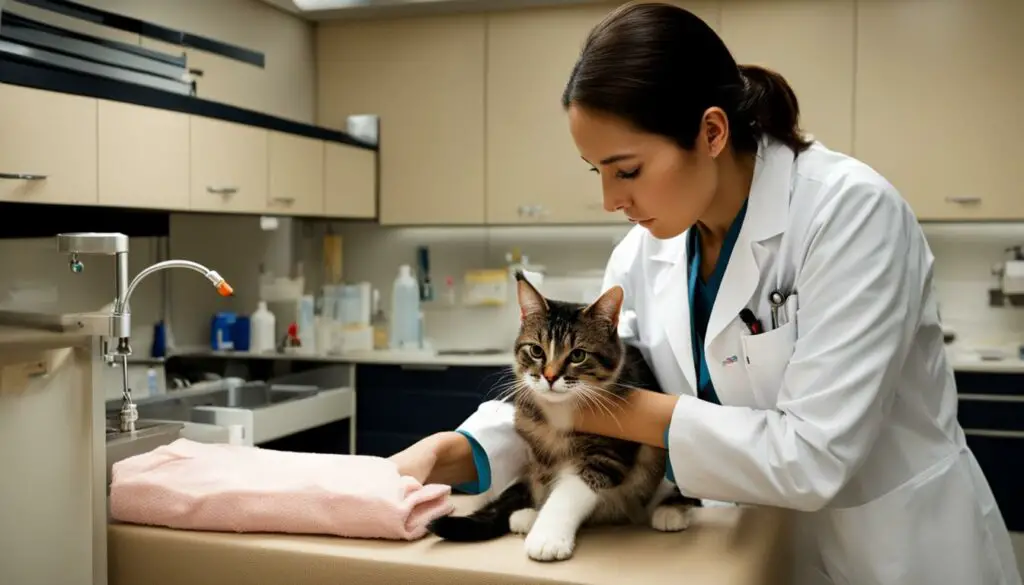
Remember, preventive care plays a vital role in keeping your cat healthy and happy. By scheduling regular veterinary check-ups, you can stay proactive in managing your cat’s grooming behavior, skin health, and overall wellness. Regular monitoring and assessment by a veterinarian will help ensure that any potential issues are addressed promptly, allowing your feline friend to live their best life.
Creating a Happy and Healthy Bond with Your Cat
Grooming routines are an essential part of building a strong bond with your cat. Regular grooming sessions not only help keep your feline friend clean and healthy but also provide an opportunity for quality time and physical interaction. Establishing a grooming routine can foster trust and deepen the bond between you and your cat.
When grooming your cat, make sure you use the right tools for the job. A soft brush or comb designed for cats can help remove loose fur, prevent matting, and stimulate the skin. Take your time and be gentle, using slow, deliberate strokes to avoid hurting your cat or causing discomfort.
In addition to grooming, incorporating enrichment activities into your cat’s daily routine can further enhance your bond. Provide interactive toys, scratching posts, and puzzle feeders to keep your cat mentally and physically stimulated. Playtime is not only a great way to bond but also helps prevent boredom and destructive behavior.
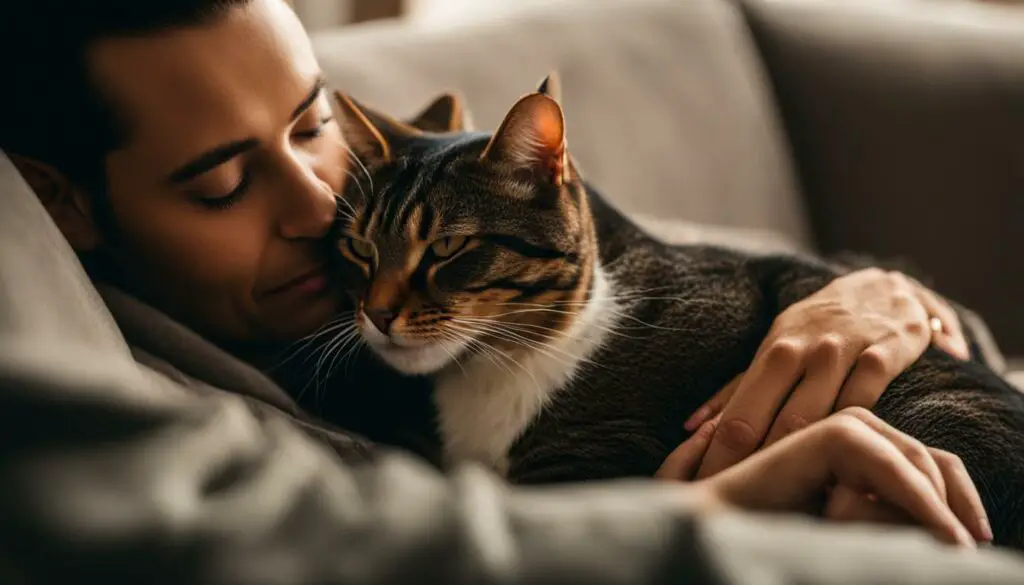
Enrichment Activities for Cats:
- Create a cozy and comfortable space for your cat with soft bedding and hiding spots
- Rotate toys and provide new ones regularly to keep your cat entertained
- Set up a window perch or bird feeder view to stimulate your cat’s natural hunting instincts
- Introduce catnip or cat grass for your cat to enjoy
| Benefits of trust-building activities: | Examples of trust-building activities: |
|---|---|
| 1. Strengthen the bond between you and your cat | 1. Gentle petting and stroking |
| 2. Increase your cat’s confidence and sense of security | 2. Offering treats and rewards during grooming |
| 3. Reduce stress and anxiety in your cat | 3. Interactive play sessions using wand toys or laser pointers |
| 4. Improve overall well-being and happiness | 4. Engaging in clicker training and teaching new tricks |
Remember, building a happy and healthy bond with your cat takes time and patience. By consistently incorporating grooming routines and enrichment activities into your cat’s daily life, you can create a deeper connection and a mutually rewarding relationship.
Conclusion
After exploring the fascinating world of cat grooming behaviors, it’s clear that when your cat licks your hair, it’s a sign of affection and bonding. Cats groom each other and their human companions to reinforce social bonds and share scents. This grooming ritual strengthens the special connection between you and your feline friend.
While excessive grooming behaviors may indicate underlying health or behavioral issues, most hair licking is harmless. By providing appropriate care and attention to your cat’s physical and emotional needs, you can help prevent excessive grooming and ensure their well-being.
Remember, building a strong bond with your cat requires trust, love, and understanding. Engage in regular grooming routines, participate in interactive play, and create a safe and enriched environment for your furry companion. By doing so, you’ll create a happy and healthy bond that will last a lifetime.
FAQ
Why does my cat lick my hair?
Cats lick human hair as a sign of affection and to reinforce the bond between you. It’s a way for them to share their scent with you and seek attention.
Is it harmful for cats to lick human hair?
Licking human hair is generally not harmful unless the cat swallows it. Swallowing hair can lead to the formation of hairballs, which may require surgery.
How can I discourage my cat from licking my hair?
You can try changing your hair products to scents that cats don’t like, providing distractions, such as toys or playtime, and ensuring alternative outlets for their oral and sensory needs.
What does it mean when cats groom each other?
Cats groom each other to enhance social bonds, mark territories with scent, and show dominance or submission within their social group.
Why do cats have rough tongues?
Cats have rough tongues because they are covered in backward-facing barbs called papillae, which help them remove loose hairs, dirt, and parasites while grooming.
Is excessive grooming a sign of stress in cats?
Yes, excessive grooming, including hair licking, can be a sign of stress and anxiety in cats. It’s important to consult a veterinarian if you notice persistent or extreme grooming behaviors.
How can I address abnormal grooming behaviors in my cat?
Depending on the underlying cause, intervention may involve medication, stress management techniques, behavior modification, or a combination of these under the guidance of a veterinarian and certified animal behaviorist.
Why is regular veterinary check-up important for grooming behavior?
Regular veterinary check-ups allow for monitoring and assessment of your cat’s grooming behavior and overall health. They can identify any underlying medical conditions that may contribute to abnormal grooming behaviors and provide guidance on appropriate grooming practices and preventive care measures.
How can I build a strong bond with my cat through grooming?
You can build a strong bond with your cat by providing a safe and enriched environment, engaging in grooming routines, participating in interactive play and bonding activities, and ensuring regular veterinary check-ups to maintain their skin and coat health.
What is the purpose of cats grooming humans?
Cats groom humans as a sign of affection and bonding. It signifies trust and allows cats to engage in intimate behaviors with their favorite humans.
Are abnormal grooming behaviors in cats a cause for concern?
Abnormal grooming behaviors, such as compulsive licking or excessive hair loss, can be indicators of underlying medical issues. It’s important to consult a veterinarian for proper diagnosis and treatment.
What should I do if my cat is excessively grooming?
If your cat is excessively grooming and showing signs of anxiety, consult a veterinarian. They may recommend medication or behavior therapy to help manage your cat’s stress and reduce the compulsive grooming behavior.
How can I create a happy and healthy bond with my cat?
Building a strong bond with your cat involves understanding and appreciating their grooming behaviors, providing a safe and enriched environment, engaging in grooming routines, and participating in interactive play and bonding activities.


